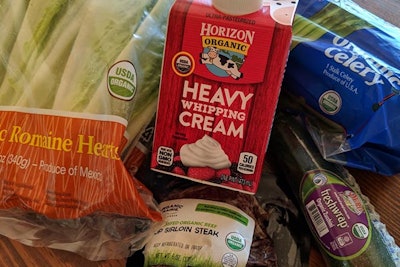
Although the growth of the organics sector has slowed somewhat in recent years, continued consumer demand for “natural” food products is drawing some of the industry’s largest players to this sector — and bringing certain ideological and logistical challenges with them.
Organic poultry production grew 18% in 2017-18, surpassing 1 million head slaughtered for the first time. Although growth is expected to continue, the breakneck growth is expected to slow in coming years. Mercaris, an organic and non-GMO commodity marketplace, projects 3-5% growth in 2018-19. Demand for organic eggs continues to rise and is expected to expand 5-8% this year. Dairy, once a primary driver of growth for organic producers, has slowed but continues to grow at about 1% per year.
But producing the feed necessary to maintain an “organic” label is not without challenges, according to Ryan Koory, a senior economist at Mercaris. Supplies of organic soybeans and soybean meal have not kept up with demand. Domestic supplies of organic soybeans are declining, resulting in a 35% increase in imports.
Koory believes changes in the organics industry have exacerbated the mismatched markets. Originally comprised of mom-and-pop farms dedicated to wholesome and ecologically friendly husbandry, the steady expansion of demand for organic products has attracted legacy food corporations to the sector. But feeding programs at these large-scale operations rely heavily on corn- and soybean-based feeds, resulting in monoculture farming that isn’t entirely compatible with the constraints of organic production.
“The reality of organic production means that you have to use crop rotation and things like cover crops,” Koory said, “which limits your ability to add acres.” Organic soybean farmers simply can’t expand their acreage fast enough to keep up with demand for organic poultry feed.
A truly organic feed, Koory said, would not only comply with the label’s rules but would include a greater variety of ingredients, especially small grains, that could be rotated with traditional feed crops. But larger producers are less inclined to experiment with these novel ingredients than small farms. Long term, Koory said, dependency on corn and especially soybean imports could breed trouble for the organic sector.
“Right now, especially compared to conventional [producers], the organic sector is healthy,” Koory said. But for the long-term vitality of the industry, he said, producers need to have a conversation about “monoculture practices, because they’re bad for organic.”
Conversations about longstanding agricultural practices could test the integrity of the organic label in the years to come, Koory said, but for the time being, the organic sector expects continued growth.
“In general, the organic sector is sitting on solid footing,” he said, “especially compared to what’s going on in the conventional sector."

















